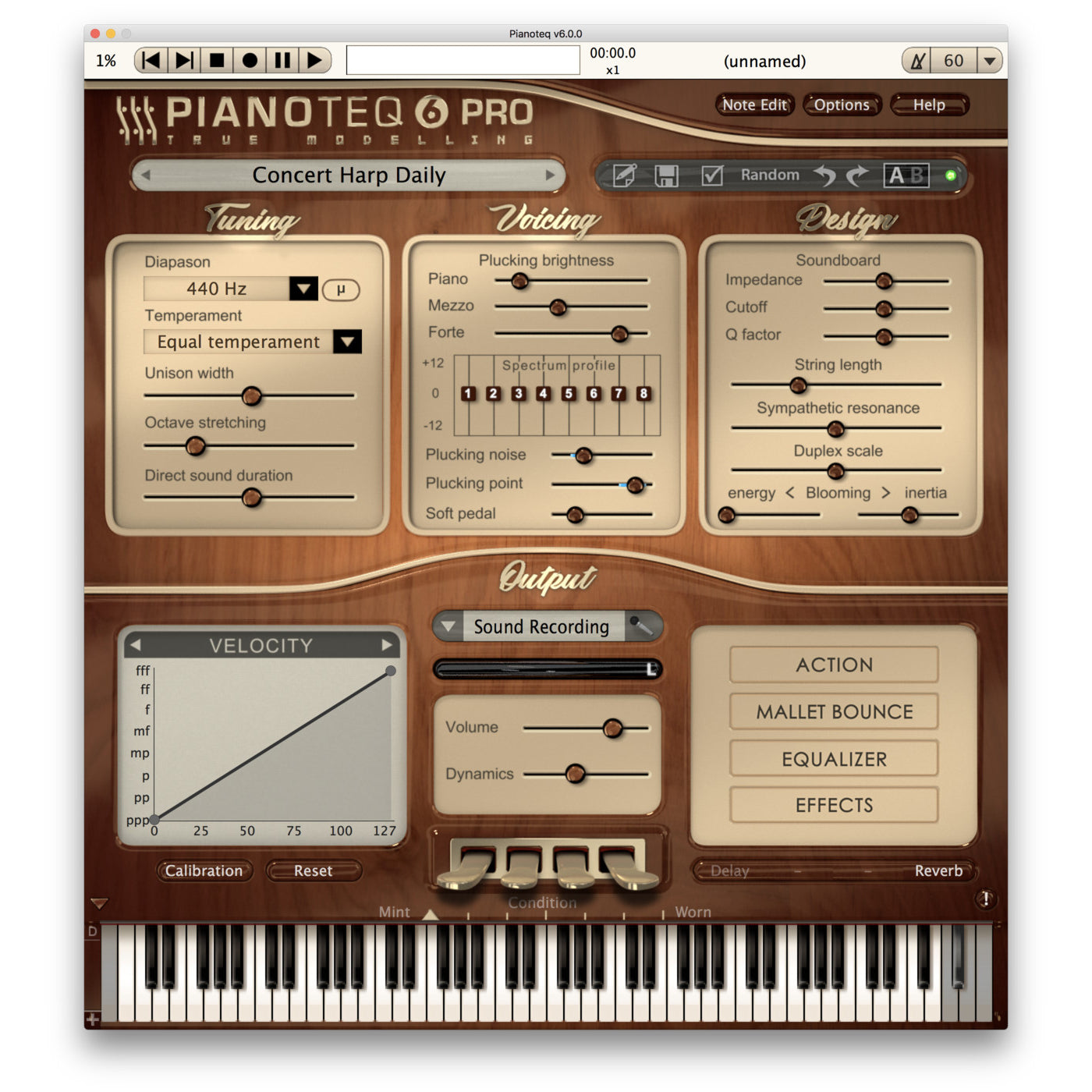Description
Pianoteq Harp Concert Harp Virtual Instrument || Your Digital Software Registration Code and Instructions Will Be Sent to You, Along With an URL Connecting You Directly to The Manufacturer, Who Will Provide You With Your Software Digitally. Please Be Aware That Software Is Non-Cancelable and Non-Returnable. If you have any questions about this product please do not hesitate to contact us. Guildwater Gear is an Authorized Pianoteq Dealer through the Xchange Market. There, You Can Find Us Among Their List of Authorized Resellers.
This Concert Harp for Pianoteq is physically modelled after a Salvi concert grand harp. It allows to play pinch harmonics (flageolets) and glissandos. It includes a diatonic mode with seven pedals to change the pitch of the strings and play in all keys.
The harp has appeared in many forms since as early as 3500 BC. The pedal harp appeared around 1700, and was improved in 1810 by S. Erard's double movement, which allows to play in all keys and is still today's standard for the concert harp. The harp was extremely popular in the 18th century, used by many baroque and classical composers of the time (Händel, Mozart and others) and later started to appear in operas by Puccini and in symphonic music and ballets by Liszt, Berlioz, Massenet, Debussy, Tchaikovsky, Wagner and others. The harp is also featured in modern music, appearing in works such as "She's Leaving Home" by The Beatles and "Dark Lady" by Cher. In the Marx Brothers movies, the very skilled harp player by the nickname Harpo often dedicates entire scenes playing the harp. The concert harp possesses 47 strings attached to a soundboard, and is played with the fingertips of the first four fingers with both hands. Since there are no damped strings during playing, the harp has a special magical sound which the Pianoteq technology manages to capture with astonishing authenticity.
On a harp, a double action of the hand - simultaneously plucking and touching the string in the middle - produces pinch harmonics containing only even harmonics and producing thus a note which is one octave higher. In this excerpt of "Vers la source dans le bois" (Marcel Tournier), the first sequence of tenor notes C#3, E3, B2 is played normally (C3 = middle C), whereas the second sequence of tenor notes C#2, E2, B1, is played using the Pinch Harmonic pedal. The latter is played one octave below the first sequence, but sounds at the same pitch because the string is being plucked in the middle, producing a sound containing even harmonics, hence one octave higher. Sliding quickly the fingers across the strings produces a glissando, where, because of a distinct finger position, the notes usually have a different timbre than when played single. Here we listen to a short sequence of glissandi in an excerpt of the same music piece "Vers la source dans le bois".
System Requirements
Requires Pianoteq 5.3.0 or Higher
- Mac OS X 10.7 or later, Windows 7 or later, Linux (x86 and ARM)
- Audio Units / VST / AAX / NKS compatible
Pianoteq 6 facilitates your workflow by adding compatibility with the VST3 format and the ARM architecture (Linux version only, for example on Raspberry Pi 3 boards). VST3 is the latest plug-in platform developed by Steinberg, and is supported by many audio hosts. Compatibility with the ARM architecture means that Pianoteq 6 can be used with RISC based CPU's used in smaller Linux based consumer electronic devices. Furthermore, since Pianoteq 6.1, the NKS (Native Kontrol Standard) extended plug-in format from Native Instruments is supported.
Pianoteq Features
- Pianoteq is a physically modelled virtual instrument
- Optional instruments for purchase: upright, grand pianos, rock piano, electric pianos, harp, vibraphones, clavinet, celesta+glockenspiel, xylophone+marimba, steelpans
- Free instruments: KIViR historical instruments collection, bells and carillons.
- Unique adjustable physical parameters, such as unison width, octave stretching, hammer hardness, soundboard, string length, sympathetic resonance, duplex scale resonance.
- Progressive variation of the timbre (uses all the 127 MIDI velocities)
- Control of the dynamics in timbre and volume
- Polyphonic Aftertouch (particularly interesting for the clavichord)
- Realistic sympathetic resonances, including duplex scale
- Microtuning, supports Scala format *
- Adjustable mechanical noises (sampled or modelled)
- Built-in graphic equalizer
- Built-in graphic curve for key velocity, note-off and pedal
- Keyboard calibration assistant
- Ten types of pedals (that can be assigned to the four UI pedals): Sustain, Soft, Harmonic, Sostenuto, Super Sostenuto, Rattle, Buff Stop, Celeste, Pinch Harmonic, Glissando
- Progressive sustain pedal, allowing partial-pedal effects
- Convolution reverberations
- Effects: Tremolo, Wah, Chorus, Flanger, Phaser, Fuzz, Delay, Amp, Compressor, Mini-eq.
- Mallet bounce (note repetition)
- Instrument condition (mint to worn)
- Variable lid position *
- Five adjustable microphones *
- Multi channel - up to 5 channels *
- No quantization noise (32-bit internal computation)
- Renders high resolution MIDI formats CC#88 and Disklavier XP.
- Installs and loads in seconds
- Extremely small file size (less than 50 MB)
- Excellent for use on modern laptops
- Extended key range (105 keys = 8+2/3 octaves) for the grand pianos Steinway D and K2
(* in Standard and PRO versions)

